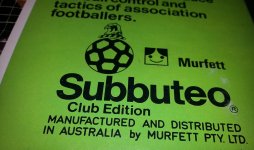
| Peter Upton's |
Subbuteo Tribute Page. |
|
The Boxed Editions |
|
Page 5: International Sets and Boxes. |
Subbuteo has been exported all over the world, and is played wherever real football is enjoyed. Most of the Subbuteo that found its way overseas seems to be identical to that found in Britain. Okay, so there were different teams produced for different markets, but the boxes tended to be the same.
However, access to ebay and contact with overseas fans has allowed me to assemble this page of box sets produced exclusively for international markets, and not advertised in Britain. I expect there are more sets out there, so if anyone has a different set to show off, then please feel free to mail in a picture.
December 2012: The page was getting confusing, so I've rearranged
it into alphabetical order of countries.
August 2015: Check out Franco Esposito's website
www.thesubbuteomuseum.com for much
more detail and lots more detailed pictures of these international sets (and
more).
Australia.

Late 1970s - Murfett Pty. Ltd.
This first club edition is the standard late 1970s set, but with the logo of Australian toy company - Murfett Pty Ltd printed on the box. Interestingly, the set stated that it was "manufactured and distributed in Australia". How much stuff was really manufactured outside the UK though? Of the two Murfett sets purchased in Melbourne by contributor Paul Hindmarsh, one had heavyweights in red and blue, whilst the other had a blue heavyweight, but a red zombie. Both sets had polystyrene inserts.
I have also seen the late 1970s Subbuteo rules/handbook issued by Murfett, who, according to the leaflet, had offices across Australia at the time. The back page of this rulebook was given over to a list of other Waddingtons games also sold by Murfett including Scrabble, Cluedo, Dracula, Totopoly, and Black Box (a game notable for being advertised on Subbuteo fencing in the late 1970s!)
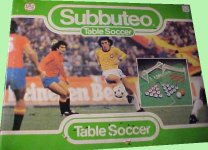
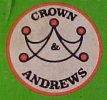
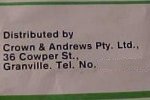
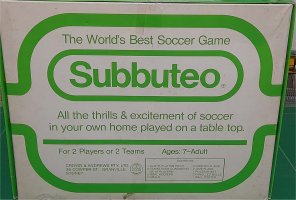
Early 1980s - Crown & Andrews Pty. Ltd.
A standard club edition - but with details of a different Australian distributor added to the box, and instructions. This arrangement seems similar to that used by Jokari who distributed in America. This also suggests that Subbuteo did arrive in Australia in some quantities, rather than just being taken over there by English emigrants/visitors. Worth noting here is the fact that the box repeats the words "Table Soccer" where an English version would say "Club Edition". This suggests that there was only one edition to choose from in Australia.
January 2024: Collector Giovanni Buscemi has found the the reverse of the Crown & Andrews set is actually more interesting than the top, because it is (I think) unique to this distributor.
Belgium - Football de Table/Tafel Voetbal.
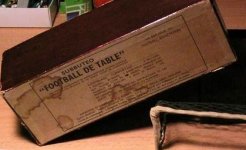
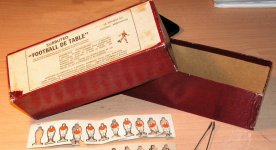
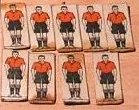
Subbuteo was introduced to Belgium by Peter Adolph as early as 1949. The original Belgian organiser was George Samson, who went on to become managing director of Subbuteo Sports Games Ltd in the early 1970s. The two box sets shown above are from the earliest days of Belgian Subbuteo. The set on the left, with no logo on the lid, and card cut-out figures, is likely to be as early as 1948-49. One of the cut-out teams in this set was reference 14, which represented Belgium. The second set had press-out teams in the standard colours, and dates to around 1950. Perhaps the most interesting thing about these sets is the deep boxes, which allow the goals to be stored when assembled. British Assembly Editions did not receive these deeper boxes until much later on.
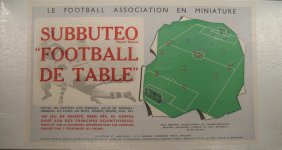
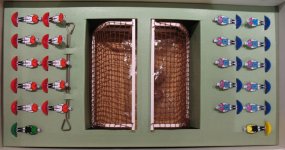
Although the lid design of this Belgian set looks like it came straight from the 1950s, the paperwork supplied with it came from the early 1970s, and featured pictures from the original Subbuteo World Cup of 1970. At the time, the European Table-Soccer Federation (ETF) were still playing the flat-figure game, and I suppose it made sense to provide these sets to ETF players. However, the warehouse stock of these sets that turned up in the 2000s, suggests that it wasn't as big a seller as was hoped. The set was the size and equivalent of the UK Combination edition, and had a piece of chalk supplied rather than a pitch. However, the Combination does not have the lovely cardboard inner display. These editions have been seen with the standard red and blue teams, or an alternative version shown here, with the blue team replaced by Barcelona. That suggests a European Cup Final to me (Benfica vs. Barcelona), but that took place back in 1961. So either the sets were old when the 1970s paperwork was added (hence the box style), or this is just wishful thinking on my part (which is more likely to be honest!).
Belgium - Derby Edition.
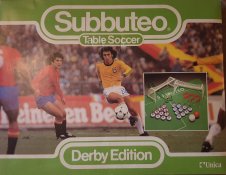
In the 1970s and 1980s the Belgian distributor was Unica, a company based in Kortrijk. The instruction booklet for these sets was a two colour red and black affair. This was a reversible booklet, with rules in both of Belgian's national languages back to back. This "Derby Edition" is from the early 1980s. It is essentially just a standard club edition with red/white and blue/white teams.
A big thank you to Italian collector Cristian Giovangiacomo, who sent in the details of this set.
Brazil - Pelebol
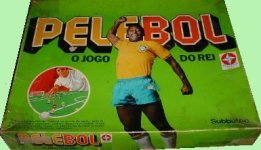
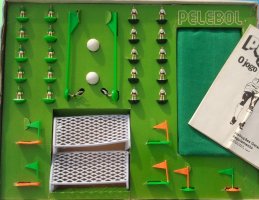
A very nice variation this one. Made under licence in 1979 by big Brazilian toy company Estrela who were based in Sao Paulo. The small Subbuteo logo, and the circular box picture date nicely to the late 1970s. A big thank you to Subbuteo fan Pasquale Carrassi who lived in Brazil at the time, and has provided all the extra details for this rare edition.
The club edition of Pelebol was actually produced in two versions - ref 20.18.20 with Santos (all white) and Flamengo (red shirts/black shorts), and ref 20.18.21 with Corinthians (white shirt/black shorts) and Palmeiras (green shirt/white shorts).
Pelebol had a range of six teams (including the four available in the sets), which were produced in the moulded feet version of the heavyweight player. These were produced and painted in Brazil. In Europe, we don't have moulded feet players beyond the early 1970s, which suggests that the moulds may have been exported. The teams were sold in card boxes similar to those of the early 1970s in Europe, but these also included an instruction booklet and a ball. See the International Team Production page for details.

If you look at the interior illustration above, you should see that the pitch has the Pelebol logo, the goals are a simplistic moulded plastic affair, and three of the flags are in reverse colours - i.e. green flags on orange bases. Most strange. Odd coloured plastic continued into the teams. Pasquale also mentions that the figures were produced on white, red and yellow plastic for outfield players and grey for the goalkeepers. As an aside, Estrela did the same thing with Playmobil in the 1990s, producing the standard (white) European release spaceships in brilliant colours - a little bit of samba going on?
Pelebol also had the following basic accessory range -
Despite being a football mad country, and despite the game having the Pele branding, Subbuteo/Pelebol in Brazil was not a success, and was only on sale for one year. Pasquale Carrassi has this reasoning for the failure -
"They were difficult years for the country, already struck by a strong inflation since the early seventies, which ended up causing the collapse of the local currency Cruzeiro and the ephemeral introduction of Cruzado in the middle of the eighties. Moreover in the course of 1979 the second international oil crisis broke out and had particularly devastating effects in Brazil, with repeated forced devaluations of Cruzeiro.
Only a privileged fews could afford the luxury of buying a Pelebol set, known as Pelebol Grande (the complete box) and Pelebol Pequeno (the simple team plus ball set)."
Luckily, Pasquale was one of the few who obtained the game(s) and the teams, and so the information lives on!
France - Super Match Edition.
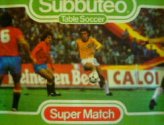
I'm relying on Subbuteoworld again for this one. The set had English wording, but wasn't sold over here. Instead it was exported to France. This contained a scoreboard, championship goals, and four teams - England, West Germany, Argentina, and Brazil (also the countries in the World Cup Winners Pack).
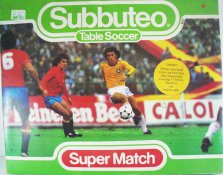
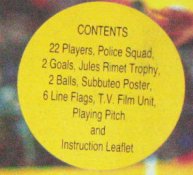
February 2015:- A second "Super Match" set has come to light, with different contents to the one sold on Subbuteo World. This oddity had the polystyrene inserts from the floodlighting set, but as the contents sticker above shows, it did not contain the floodlights. Instead, these larger spaces were filled with a Jules Rimet trophy, the police squad, and a TV Film unit. The "Subbuteo Poster" mentioned in the contents is simply the 1982 catalogue-poster.
Coupe d'Europe Edition.
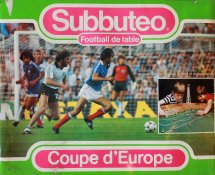
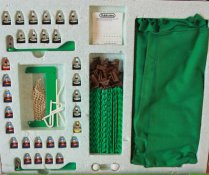
March 2020: Website visitor Giovanni Buscemi picked up this set via French ebay - one neither of us had seen before. It is a French language version of the Euro 1984 edition. I'd long assumed that set was really aimed at the continental market, because holders West Germany, and hosts France were not going to be a big sell in the UK (in a tournament where none of the our "home nations" had even qualified). Still, here is evidence that the English language version was really for home use, as the French had their own set.
The box has some extra text on the lid "Subbuteo, un vrai match de football: dégage, dribble, fais des passes et marque le but!"
The Interior of the set is identical to the standard European Edition, with two full squads (including a spare goalkeeper), plus fence and number transfers.
The set was advertised in the MAKO S.A catalogue of 1983 as a new item, but wasn't illustrated at that point.
The catalogue offered a full range of box sets including League, and Club, both of which are shown below.
France - Championnat de Ligue (1983-84)
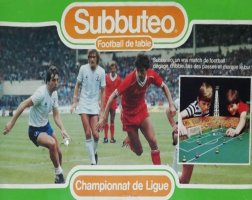
This is another of the Football de Table French sets of the mid 1980s, this one being the League Edition, which was a renamed Display Edition of course. It was given a French name, and the extra box writing on the European Edition (shown above) repeats here, and on the Inter-Club box.
France - Inter-Clubs Edition (1984).
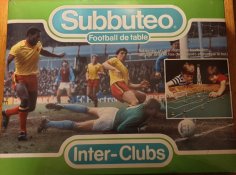
This set is a French Club Edition with a slightly eccentric name. The lid has the same extra text as the Coupe d'Europe version shown above, and is the same era. The interior is identical to a standard red/white, blue/white Club edition with big orange flags included. The 1984 poster was also included, dating it very nicely.
A big thank you to Stuart Phillips, who owns this set and kindly sent in pictures and details to the site.
France 98 - Coupe du Monde Edition.
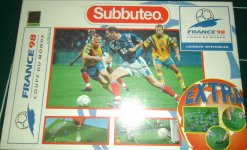
As with Euro 1984, hosts France had their own language version produced for the 1998 World Cup set. In this case, the standard version had featured a cover photo from the previous World Cup final featuring Brazil and Italy. However, the French version has the hosts playing (versus Sweden). It also reverses all the other parts of the lid, with the France 98 logo running down the left hand side of the box, rather than the right.
May 2023: To my surprise, a further France 98 set has come to light featuring Spain as a third team. See the bottom of this page for details.
Germany - Tischfußball.
1960s - Vetrieb Czarkoski, Solingen.
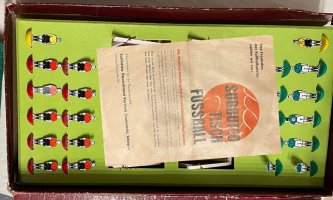
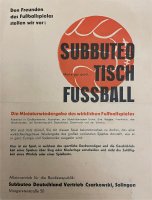
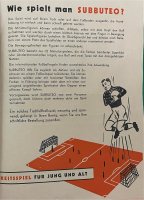
I knew from my researches into Subbuteo tournaments and Associations (see Subbuteo Assns intro) that West Germany were one of the early adopters of Subbuteo alongside the low countries. However, I had never actually seen a German set from the "flats" era. A big thank you then, to Italian collector Pasquale Carrassi who supplied the pictures of this set and rule book. The leaflet is dated to August 1961. The German distributor is listed as Vertrieb Czarkowski. As an aside, his son Peter won the original Subbuteo World Cup in London in 1970.
If you are wondering why the box lid isn't illustrated, it is because this set came in a simple plain brown box. The set has 1960s plastic goals, and is laid out in a similar fashion to the Belgium set shown above, However, Pasquale advises that his set came with a logo-free dark 1950s style pitch in the bottom of the box. Pasquale points out that the leaflet has similarities with those in the celluloid Dutch sets. The teams are references 14 and 15 in celluloid. As Tipp Kick sets are wont to highlight, the red/white and blue/white colours are used much less in Germany, and so this contrast probably works better.
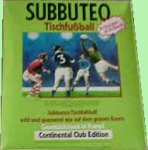
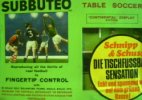
1970s Schnipp and Schuse.
Perhaps it was in response to the Munich World Series of 1974, but the early 1970s box sets seem to have been exported to Germany in reasonable numbers - and probably account for the strong support the game has in that country. The display edition illustrated is just a normal British box with a big sticker in German on it, but the Club Edition is the real thing - this is Subbuteo Tischfußball :-)
Pictures of the full range of sets of the time suggest that whilst all the editions of the early 1970s right up to the Munich were available in Germany, it was only the illustrated Club Edition that received a unique box lid. All the others made do with stickers. I guess Club Editions were always the big seller.
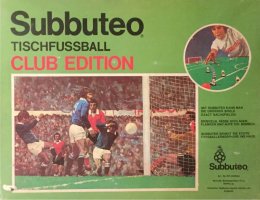
Here is the standard late 1970s Club Edition converted into a German language set. This one appears to have yet another German Distributor, with a company based in Hamburg mentioned on the box lid (I can't quite make out the letters on the picture I have on file.
Germany - Europa Cup and World Cup Editions.
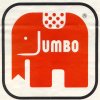
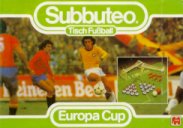
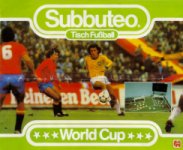
1980s Jumbo.
The words "Tisch Fußball" also give the game away here. These are German sets from 1983, and the distributor is now a company named Jumbo. The Europa Cup set is actually just a standard club edition, while the World Cup version features West Germany vs Holland, and FIFA balls, and also has the addition of a fence, a scoreboard, and perhaps oddly, two throw-in figures. The interiors of the sets are moulded green plastic, pre-dating the English plastic inners by about a decade.
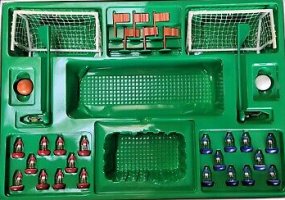
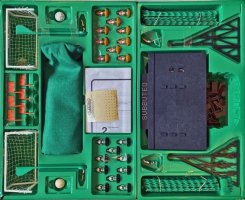
August 2022: Ashley Hemming sent me this picture of the interior
of the Europa Cup set, so that the unique plastic inner is highlighted. The
design is odd, although I suppose the goalkeepers pointing out from the goals
makes some sense. The central area is obviously for the pitch, but the other
hole seems to be spare.
October 2023: Ashley completes the Jumbo set interiors with this picture of the
World Cup set. As shown in the catalogue, this set does indeed feature West
Germany and Holland as the teams, and it has a pair of throw-in figures in the
correct colours. Once again, the goalkeepers are set facing out from the goals.
It is an attractive design.
Japan.
1970s United Industries Limited.
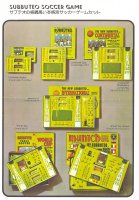
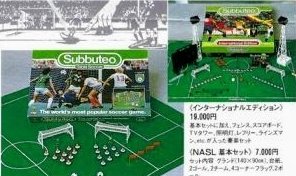
Various Japanese language catalogues and rule books have appeared in collecting circles, but sadly it looks like the standard boxes were used at all times in this small outpost of the Subbuteo community. You would assume that some kind of Japanese language on the box explaining the game would have been helpful to sell the product. Mind you, I don't really know how niche Subbuteo was in Japan. Was it just mail order?
Anyway, I thought I would include the pages of box sets from the known Japanese catalogues on this page just in case anyone was wondering... It is worth noting that the later mid 1980s catalogue has two sets offered - the standard International Edition and the American NASL edition produced by Jokari. This was a little bit of a surprise, and asks the question of who was actually supplying this market at that point. From a worldwide perspective, it might have been easier/cheaper to export to Japan from the USA rather than from Europe. Or perhaps the NASL had proved a reasonable draw in Japan.
Netherlands - Tafelvoetbal.
1950s Distributor Es-Es-Es,, Voorburg.
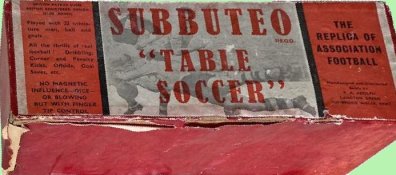
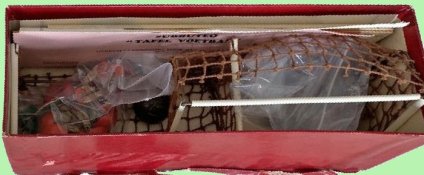
The Netherlands were one of the first countries that were introduced to the wonders of Subbuteo. That doesn't seem particularly surprising considering their proximity to the UK, and their love of the full size "beautiful game". I believe the Netherlands Subbuteo Assn was formed as early as 1954. This deep box edition is a small assembled set (similar to the Combination sold in the UK), and is near identical to those sold in Belgium in the early days (see above). However, this Dutch set is slightly later in date, and features the English label from the early 1950s Assembly Edition. This means it is probably quite close in date to that 1954 Association founding. The distributor of these early sets was the wonderfully named Es-Es-Es trading company. They produced a Dutch language version of the rule book, and of the player assembly sheet. Their order form allowed customers to purchase the full range of spares, and teams up to reference 24.
The instructions call this Tafelvoetbal, but the English box label keeps the game as Table Soccer, and that is repeated on the more deluxe set that was released later (see below).
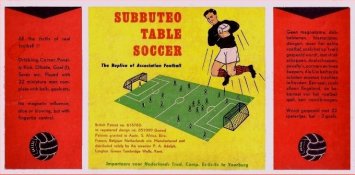
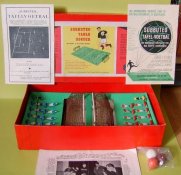
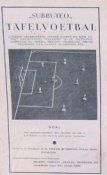
February 2015: - The Subbuteoworld website originally illustrated this Dutch edition from the late 1950s, and it is now illustrated here too. No pitch was included, but the set has a nice green inner displaying the contents (which the English Combination set lacked), plus a translated rules book (the same one as the early set shown above). Although the text on the lid is now in Dutch, the game is still called Subbuteo Table Soccer on the box.
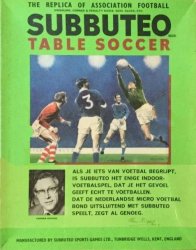
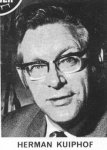
The game in Holland received a further boost in the early 1970s, when the OO scale Club, International and World Cup sets were made available. These sets were sold in the English boxes, but like the Swedish set, they had a sticker attached in their own language. The set that my info comes from is a club edition, and on that set the sticker covers the bottom third of the box, and features a picture of Herman Kuiphof. As you would expect, the box sets were supplied with a Dutch instruction book, and catalogue. The instruction book also had a picture of Mr Kuiphof, and some words of wisdom from the great man.
I have now been enlightened about Mr Kuiphof's greatness. He was a famous football commentator from the 1960s until the 1980s, and his commentary on the 1974 World Cup Final is especially legendary.
These box sets were supported by the addition of Dutch teams to the official team charts. This addition also saw eight brand new club colours added to the team list on numbers 82-89, which was the first time that kits used exclusively by overseas club sides were added to the list en-bloc.
1980s Distributor - Clipper Games.
Club and Europacup Editions.
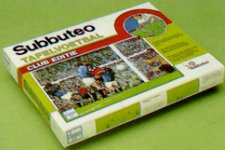
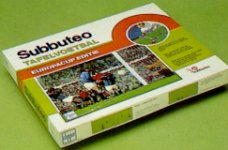
Produced by Clipper Games (makers van Monopoly!), these two box sets use the illustration from the late 1970s English boxes on a more colourful background. An interesting anomaly in the Dutch catalogue of this era is that they are still selling the early brown scoreboard, but it been given a reference number of 070158. In England, C158 was only ever the newer black scoreboard. The box sets, (and the scoreboard) continued to be sold in the early 1980s.
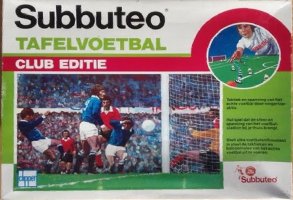
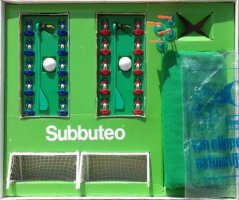
October 2023: Details of the Club Editie set have come to light. The box interior is unique to this set, and as with the Europacup set shown below, the teams are in separate boxes, with a modified plastic interior which has room for a ball. As with many late 1970s sets, the teams are standard zombies in red/white and blue/white. There us a plastic bag with "Clipper" logos, which I'm assuming protected the pitch originally. There is a square cut-out that I'm assuming was for the flags. Whether they had a bag, or maybe a box to protect them is not known.
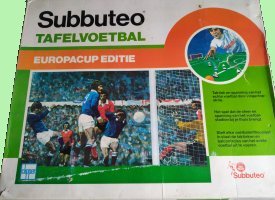
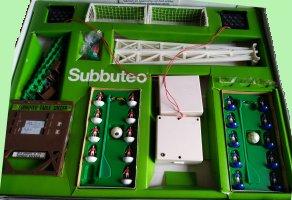
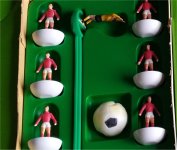
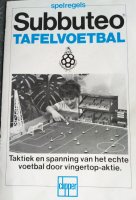
January 2021: A little treat from collector Vincent Guyaux, who has provided some detailed pictures of his Europacup Editie. This is the first time I have seen the interior of this set. The obvious thing to say about it is that we now know it to be a unique Floodlighting version. It is worth admiring the eccentric layout of the box to allow for the various bits of the floodlights, and the addition of a vintage brown scoreboard, which I had mentioned was still in the Dutch range, but I did not realise would actually feature in the set.
The teams have their own box interiors, and note that these have a place to hold the balls. This is useful with this set layout, but would be a bonus if the teams were sold separately like this (something only seen in Pelebol I think). The teams are the unlovable zombies in red and blue, and the clipper edition of the Subbuteo rules in shown to complete the picture.
A big thank you to Vincent for sending this one in.
Nutricia Chocomel Editie
![]()
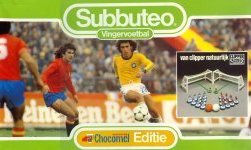
This lovely little set is a Dutch League Edition (that's a Display Edition to all you oldies out there!). You can tell this by the lack of a pitch under the teams on the box lid contents picture. As with the late 1970s box sets, this edition was produced by Clipper Games, but it also had a sponsor - "Nutricia Chocomel". From their logo, this product appears to be some kind of chocolate drink. If anyone knows why this edition was sponsored, I'd love to know. The box also calls the game "Subbuteo Vingervoetbal", although the instruction book, catalogue etc, still call it "Subbuteo Tafelvoetbal", as per earlier editions. Mind you, the catalogue is advertising the late 1970s sets, so the paperwork is probably identical to these earlier sets.
Inside the box is the usual attractive League Edition, which has the teams, balls and goals laid out on green card (has anyone seen a League Edition in polystyrene?). In a nice touch, the teams provided are Holland (013) and Belgium (151) in machine printed lightweight figures. All ready for that local derby :-)
Thanks to Paul Woozley for selling me this set at the Woking swap meet .
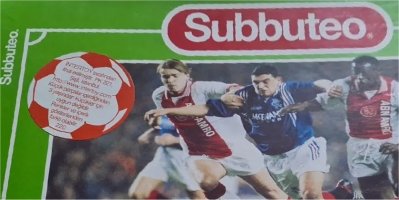
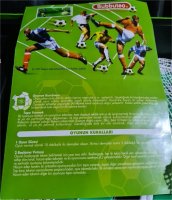
As a rule, I don't normally feature the 1990s sets on this page, because all the standard sets were designed to be sold internationally. This was done by removing the large English language titles (like Club Edition), and putting the small print in an assortment of common languages. The rules sheets tend to fold out into vast numbers of languages.
That said, occasionally an interesting regional variation exists. This 1997 Hasbro set has a small Dutch language sticker on the lid. So far, so ordinary (I'm sure I have an English set with similar sticker). Oddly though, the Dutch language rules are unique to the set. The player picture is familiar enough from the rule book of the era, but here it is on a single language sheet. A surprisingly little find.
New Zealand - 1970s.

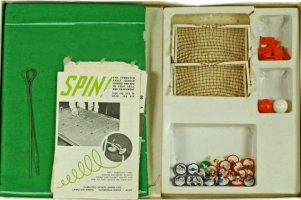
Here is a Subbuteo edition with a completely different box lid. I'm not sure if this was exclusive to New Zealand, but at present that's the only country where it has been spotted. The contents are just a standard mid-1970s club edition. The kids in the illustration are typical of Subbuteo advertising of the 1970s, and like most of us, they are playing Subbuteo Floor Soccer, rather than the Table variety. Note the classic 1970s accessories - World Cup goals, white floodlights, and green fence surround. There's no stadium at this stage, so the kid with the goalkeeper is actually playing properly.
October 2023: The interior of the New Zealand set is now illustrated, and it consists of a simplistic design in a flimsy white plastic. There are rather basic indents in the plastic to allow for the contents to be stored.
The Subbuteo Museum has this set shown with a card interior which again is different to a standard UK Club Edition. It also repeats the trick of having the pitch take up half the box.
Rather oddly, the white plastic interior has also been seen in a Greek Club Edition of the same vintage (which isn't illustrated here yet).
New Zealand 1980s - Theo Holdsworth & Sons Ltd.

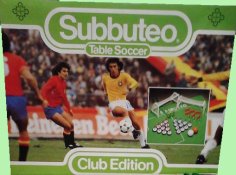
By the 1980s the New Zealand Club Edition had taken on a more familiar look, at least externally. As with the Australian editions of the period, only the printed logo of the distributor marks the set out. The New Zealand distributors were a company called Theo Holdsworth & Sons Ltd, Auckland, who use an abbreviated "Holdson" name in their logo.
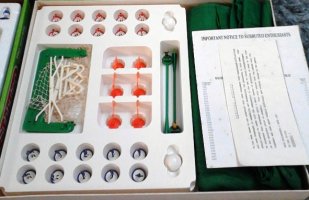
As hinted above, whilst this set looks boring from without, it gets much more interesting inside. Here the insert was of a unique plastic design, and only covered about two-thirds of the box. The other third gave amble room for the standard Subbuteo pitch. The players were housed upright (Hasbro repeated this trick fifteen years later). Tournament goals were provided. These were supplied flat-packed, and there was no room in the box to store them assembled. An extra note was included regarding assembling and disassembling the goals. The most quirky thing about the New Zealand set was the flags, which were produced completely in orange plastic - including the round bases. This is perhaps worth comparing with the "reversed colour" flags of the Pelebol set.
July 2007: New Zealand collector Kevin Blair has sent me
the scans from a New Zealand version of the 1981 catalogue, which was altered to
fold out in to a poster. Holdson then used two of the panels of the poster to explain
the items which they would be selling through leading toy stores. The accessory
range was simply C102, C108, C121, C127, C128, C131, C132, C133, C158 and C182.
The teams were confined to 009, 013, 021, 025, 041, 047, 050, 067, 100, 156, 174,
191, 318, 329, and 355. 156 was New Zealand and 174 Australia. Some of the other
references mentioned also featured teams from New Zealand, and these have been listed
on my Rest of World appendix page.
Summer 2012: The Holdson catalogue is now illustrated - see
Catalogues - Japan & NZ
Portugal. Modelo "Clube"
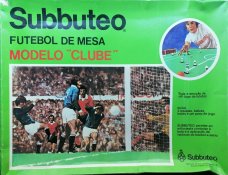
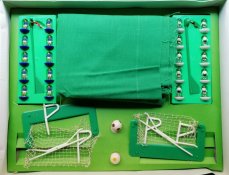

Whilst the common "club edition" box lid of this set suggests a familiar item, this one is a little different. This is because Portugal, unusually, actually produced its own Subbuteo under license. It has to be said that the Portuguese production is not of a great quality. The card is thin, and the teams are generally poorly moulded. The set shown has teams in the Portuguese hybrid figure (heavyweight copies on lightweight style bases). The teams come in the colours of France and Germany, and actually they are nicely painted. The France is essentially a ref 164. The West Germany has sleeve trim, which suggests a copy of ref 445 more than 156. With this, the set looks a little like a copy of the European editions produced for Euro 1984. The set has a card interior. The cut-outs for goals were probably not for the enclosed Tournament set. The teams are supplied in the unique Portuguese plastic interiors (designed for their single team sets), which simply slot into the card box.
Big thanks to Karl Warelow who spotted this lovely set on ebay.
Portugal - Newspaper Promotional
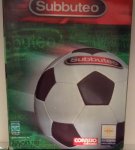
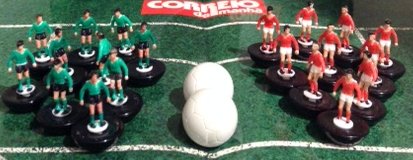
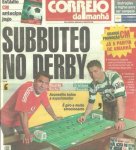
This set is another unusual item. It dates from 2003, which is one of the quieter periods of Subbuteo production. It was produced by Hasbro for a Portuguese newspaper promotion. The paper shows a couple of guys in the shirts of Benfica and Sporting (Lisbon), getting down to some serious Subbuteo competition. Only, perhaps not so serious, as the pitch supplied is a paper one, and the ball is really going to run on that. Better than the pitch are the teams, which are red and white, versus green and black (both with white v-necked trim). Note that the Sporting team does not have hoops, but it does seem to be unique to this set. Another oddity is that both teams are supplied on black bases. That's not the most sensible decision.
Spain.
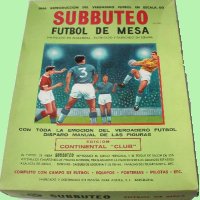

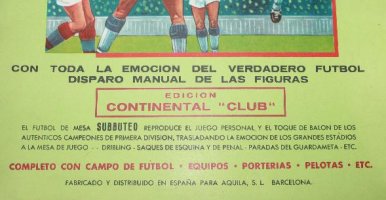
February 2015:- To my surprise, specially printed Spanish sets from circa 1965 have appeared in collecting circles. This is a very early date for such a set, with the German and Dutch versions on this page being based on the later 1970s editions. However, as Peter Adolph had a factory in Barcelona, I suppose it made sense to sell copies to the fanatical football fans of that city, and beyond..... (these sets do state that they are made in Barcelona).
The Spanish production saw versions of all three Continental editions of the 1960s. Spanish paperwork has them priced as follows:
Continental Display - PVP - 250pts
Continental Club - PVP 525pts
Continental Luminoso (Floodlighting) - PVP 892pts
Thanks to Franco Esposito for the original pictures. Check out
www.thesubbuteomuseum.com for more
details.
My site now has pages dedicated to this obscure Spanish range -
Spainish production 1960s,
Spanish teams
Spanish Editions - 1982 onwards.
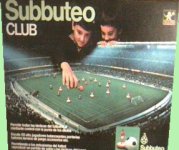
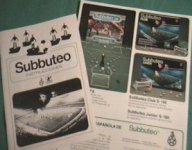
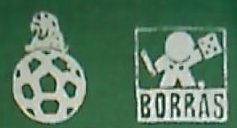
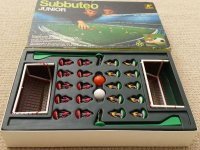
I'm not sure how these sets came about, but they was made by a Spanish company (Juguetes Borras) under licence from Subbuteo Games Ltd. The "made under licence" nature of these games is different than most of the other editions on this page. To emphasise the point, even the pitch features the Borras logo.
The advertising brochure with this game suggests that there were two versions produced in these Spanish boxes. The Club Edition, and a "Junior" Edition, which is essentially a Display Edition. The illustration of this set shows the smart plastic interior, featuring Spain and Brazil as the teams. The addition of the FIFA World Cup Edition to this leaflet dates this set nicely to the time of the Spanish World Cup of 1982. Obviously a useful cash-in on the football fever that would've spread through the country at that time.
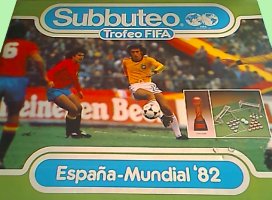
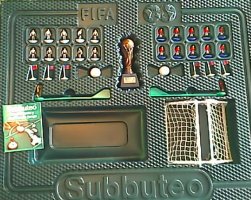
The third set on the advertising brochure shown above was the FIFA World Cup edition. This had the more familiar lid, and looked as if it was going to be the standard UK release. However, a copy of the actual set has now come to light, and it is much more interesting. The box moved the FIFA markings up to where the English version says "Table Soccer", and renames the set Espaňa-Mundial '82. The interior, like the German sets of the period is flimsy vacuum formed plastic (of a type UK customers weren't cursing at until the mid 1990s!). The big difference though, is in the World Cup itself....
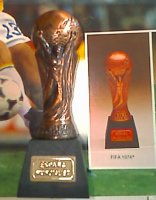
As shown on the box, the Spanish FIFA World Cup statue is a proper, high quality, metal product on a suitable plinth. I assume these replicas were already being made for the World Cup, and being obviously superior to the standard Subbuteo version, were preferred by Borras.
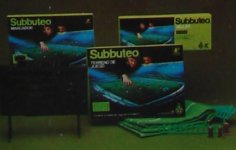
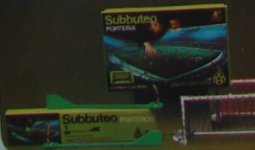
Juguetes Borras also sold Subbuteo teams and accessories in their own distinctive boxes. The bubble packed accessories seem to be the standard UK versions, but everything else - stands, pitch, goals, goalkeepers etc. were reboxed. The teams were also produced in this style, and two variations of team box suggest that the range continued for at least a couple of years, although nothing much later than this date has been seen in collecting circles. The Spanish team range was equally fantastic, with a large portion of the Spanish league covered, including team colours not produced anywhere else. The Spanish Borras Editions 1982 page will enlighten you further.
Spain - Cola Cao Edition.
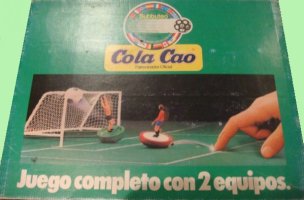
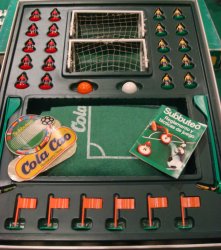
Spring 2013: Spotted on ebay earlier this year, this was another strange Spanish set, that appears to be of a similar vintage. This Cola Cao set (sponsored?) had similar contents to a standard club edition. The teams were hand-painted lightweights of Spain and Brazil (pale skinned), and the look matches the hand-painted teams seen in the Spanish team range mentioned above. It should be noted that the Cola Cao name was also printed onto the edges of the pitch. A Cola Cao sticker was also provided.
Sweden.
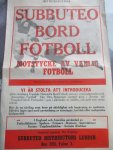

This Swedish Language promotional leaflet shows Subbuteo stretching out into Scandinavia earlier than I would have expected to be the case - the book certainly has a 1950s, or early 1960s feel to it. It does mention Subbuteo associations to contact in England, Scotland, Gibraltar and South Africa. More details (and a set?) required.....
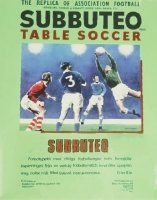
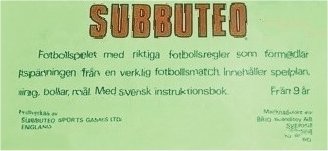
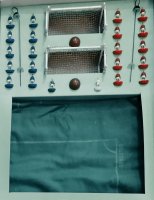
October 2023:- The 1950s Swedish set has yet to appear, but here is an early 1970s Club Edition. As with the Dutch Set shown further up the page, the English box has been retained, but the text under the illustration has been replaced with the correct language version. You can't tell from these pictures, but the set on www.thesubbuteomuseum.com has more detailed pictures, and it is obvious that the Swedish text is just a sticker placed over the English text (as was done in Holland). The contents seem to be a standard set of the period, although the box makes clear that a Swedish instruction booklet is included. The Subbuteo Museum also has similar vintage sets from nearby Denmark and Norway. Although these have unique rule books, the boxes have not been amended in any way (so they are not illustrated on this page).
Jokari Editions.
USA - NASL Edition.
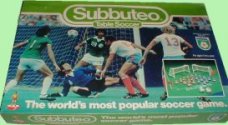
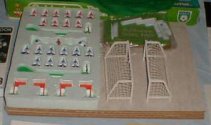
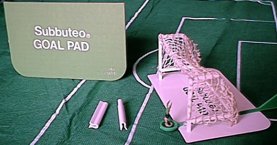
The set a generation of American fans grew up with. It's another early 1980s club edition in truth - but with a few extra bits to improve the playing surface - a paper fibre board, some clips to fit the pitch to the board, and some card goal pads to support the goals at the same height as the new board.
The International Edition (circa 1985-6).
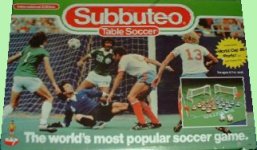
This set is a simple update of the NASL edition. The version shown featured a "World Cup 1986 poster", and so is probably dated just after the demise of the NASL. The NASL logo on the lid was replaced by an advert for the enclosed World Cup poster. You can see that this was now the red logo era. The smaller red logo in the top left corner of the box called this an International edition.
The Jokari Club Edition (circa 1985).
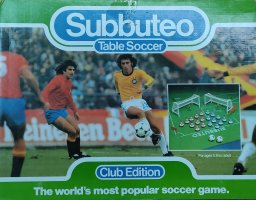
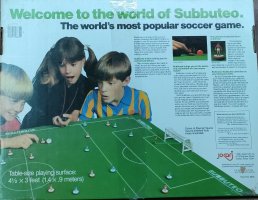
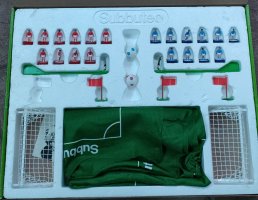
This set seems to be the final Jokari edition, and sees the familiar picture and name arrive in the USA range, with a blue logo this time. Again, this set had the 1986 World Cup poster advertised on the front, and dates from 1985. The set appears to be of a similar date to the International edition, and it has the same contents...... That is a little odd. The club edition had a full polystyrene insert (although again it only catered for four flags).
All these Jokari sets have more details (and context) on my NASL page.
USA 94 Edition (alternate boxes)
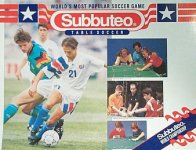
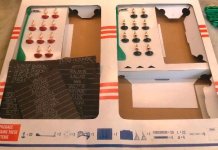
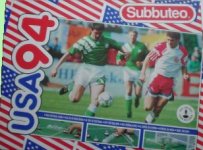
More sets from ebay, and a suggestion that the USA 94 set was produced with a relevant box lid for different countries.
The set shown on the left came from a seller in the USA. The prominent
USA player on the lid, use of the word "Soccer", and the phrase "World Championship"
rather than "World Cup" all suggests that this was another crack at the North American
market.
October 2017: - I've received a nice picture of the interior to this set,
showing a smart all-card construction. The enclosed order form listed teams available
from the US distributors, that looked left-over from the NASL era (New York Cosmos
and Chicago Sting were still on the list!). Thanks to Karl Warelow for sending this
in.
At the first glance, the set on the right looks like any other USA 94 set. However, instead of West Germany tackling Denmark, we have the Republic of Ireland doing the same thing (with Denmark in a reversed away kit). This picture was also used on the backing card for the Subbuteo electronic game.
Miscellaneous Editions.
By the later Waddingtons range, the whole Subbuteo range has obviously been redesigned for sale anywhere, with minimum use of language on the boxes and advertising material. However, there are still some extra sets to look for.
European Edition.
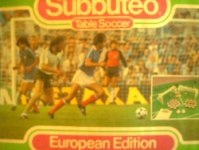
I've borrowed this set from the standard range of boxed editions, because it may well have been made for the European market. Why else have a set featuring France and Germany? It doesn't feature in any of the British catalogues I own, but it was on the 1983 price list - replacing the 1982 FIFA World Cup set. Now the French language version of this set has appeared, it seems likely that this was an optimistic UK release, rather than a pan-European one (optimistic given that none of the British teams had qualified).
Club Mexico Edition.
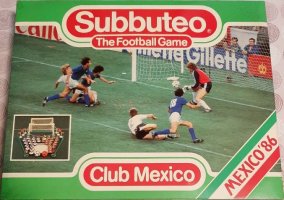
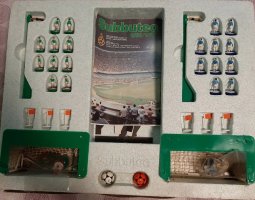
This set appeared on ebay, and could be Italian (it had an Italian seller, and Italy feature on the box). Mind you, it still has the Union Jack on the side, so it might be a British set. The contents picture is hard to make out, but it seems to be a slightly deluxe club edition with Tournament goals, small orange flags, Tango balls (one white, one orange), a set of squad numbers and the two spare "kicking" goalkeepers (as with the bigger World Cup set of 1986). The teams are full squad size (15 players). One side is reference 610 Mexico. The other is the early version of reference 415 Italy (i.e. a simple blue and white team with an Italian badge).
June 2023: Better pictures of this set have surfaced, including the inner box. This shows that the set was using the standard club edition layout of the time, and so the extra players, and spare goalkeepers were supplied in bags in the only available space (in the goal nets). In addition, the club edition box was not really designed for tournament goals, so these seem to be squeezed in upside down.
Hungary - Ferencvaros Centenary Edition.
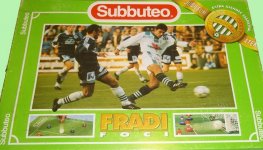
This info was sent to me by regular site contributor Gordon Watt. The set was a standard edition with some extra detail on the box, and included a Ferencvaros badge and Centenary Jubilee written in Hungarian. As an added bonus you got an extra team - which was Ferencvaros naturally. Now Subbuteo don't do Hungarian teams as a rule, but luckily Ferencvaros played their centenary season in the Liverpool away kit of the same era (742 green Adidas kit with white shoulder flashes) so they were covered :-)
October 2017:- This set is (finally) illustrated, thanks to the Subbuteomuseum website mentioned earlier. The Ferencvaros team on the box are not playing in Liverpool's away kit! Actually, I've been told that the team is not identical to a 742 as it does not feature the small white badge that the Liverpool team does. This is shown on the museum site, and actually looks like it might have been based on the Republic of Ireland Adidas away kit (ref 699) as there is a hint of orange on the collar. However, once again, there is no badge detail. So possibly a unique team to this set.
France 98 Espana Edition.
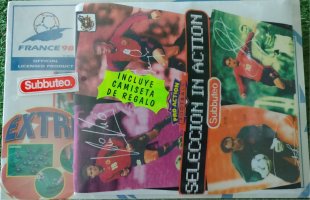
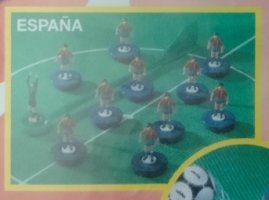
May 2023: To my surprise and delight, details of this further France 98 edition was sent in to the site by Nicola Dragoni. The more common versions of this set feature either France or England as the third team. This set has Spain as the third team (the 1998 release of this team was reference 63015 in the Hasbro team range).
If the box illustration looks strange, it is because the set concerned is still shrink wrapped, and included within the wrap is a t-shirt featuring Spanish footballers. Interestingly the shirt has both Subbuteo and Pro Action Football logos - both games being owned by Hasbro at this time. From the design of the box, we are assuming the box is otherwise identical to the standard English release (rather than the French release shown further up this page). I've placed this set in the miscellaneous section because I am not 100% sure it was unique to the Spanish market.
That's all the details I seem to have for overseas editions for the time being, but I'm sure a few more will surface over the coming months. When they do, they'll get posted here. Otherwise, it's time to pick another topic.
[ Main Page ] [ Previous Page ] [ Next Page ]